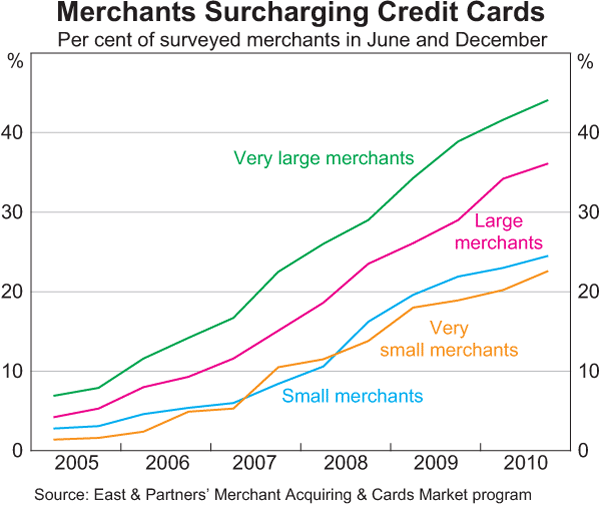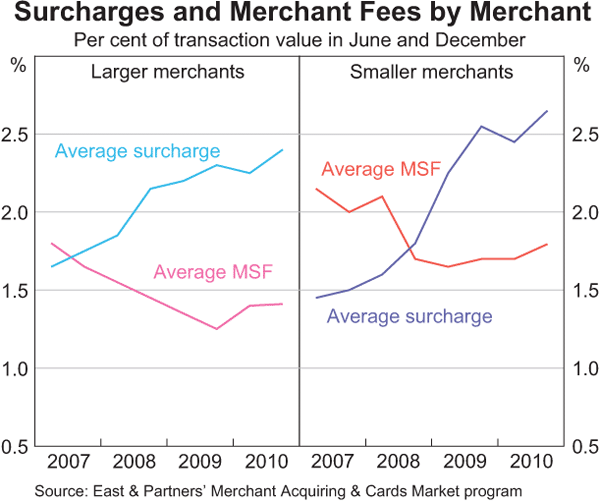Review of Card Surcharging: A Consultation Document – June 2011 2. Background
The Removal of No-surcharge Rules and Merchant Surcharging Behaviour
In 2003, the Reserve Bank began implementing reforms to the debit and credit card systems in Australia. As part of these reforms, a number of restrictions that had been placed on merchants by the international card schemes were removed. One such restriction was the no-surcharge rule, which prevented merchants from surcharging for credit card and scheme debit card transactions. These rules had masked price signals to cardholders about the relative costs of different payment methods. They had also contributed to the subsidisation of credit card users by all other customers, as merchants would build the costs of accepting card payments into the overall prices of their goods and services, which were paid by all customers regardless of the payment method they used. Finally, these rules limited the ability of merchants to put downward pressure on their merchant service fees and interchange fees by threatening to charge the customer for using a credit or scheme debit card.
The Reserve Bank imposed standards requiring the removal of no-surcharge rules from 1 January 2003 in the MasterCard and Visa credit card systems and from 1 January 2007 in the Visa Debit card system.[1] The American Express, Diners Club and Debit MasterCard systems each provided voluntary undertakings to remove their equivalent rules.
Surcharging was slow to develop among merchants in the first few years following the removal of no-surcharge rules. This likely reflected inertia on the part of merchants and the strong expectation by cardholders that no surcharges would apply, given the history of these practices being prohibited. In recent years, though, the rate of surcharging appears to have grown significantly; data from East & Partners' semi-annual survey of the merchant acquiring business suggest that almost 30 per cent of merchants imposed a surcharge on at least one of the credit cards they accepted in December 2010 (Graph 2.1).[2] Surcharging appears to be more common among very large merchants (those with annual turnover greater than $530 million), although around one-quarter of smaller merchants (those with annual turnover between $1 million and $20 million) are also reported to impose surcharges. According to these data, most other merchants are considering imposing surcharges, with only around 20 per cent of merchants having no surcharge plans.

According to the East & Partners' survey, average surcharge levels have increased substantially over the past few years (Graph 2.2). In December 2010, the average surcharge for MasterCard credit cards was 1.8 per cent, for Visa it was 1.9 per cent, for American Express it was 2.9 per cent, and for Diners Club it was 4 per cent.[3] These average surcharge levels are around 1 percentage point higher than merchant service fees for American Express, MasterCard and Visa cards, and around 1.8 percentage points higher for Diners Club cards.[4] Surcharges also vary substantially across different merchants; East & Partners' data indicate that around 10 per cent of surcharging merchants apply a surcharge of 5 per cent or more.

Consumer Responses to Surcharging
In the Board's view, the benefits from the removal of no-surcharge rules have been substantial, particularly in improving the price signals cardholders face when making payments. While merchants that apply surcharges are becoming increasingly commonplace, consumers appear to respond to price signals by avoiding surcharges where possible. According to the Bank's 2010 Consumer Payments Use Study, consumers paid a surcharge on just 5 per cent of their credit card transactions over the one-week diary period, with this proportion little changed from a similar study conducted in 2007 despite the greater prevalence of surcharging.[5] These surcharges were found to be most commonly paid in the holiday travel industry (44 per cent of credit card transactions in that industry). This possibly reflects the fact that for this industry, online purchases are more common than in other industries and credit cards provide the most readily available means to undertake online transactions. In addition, most hotel or car rental bookings require a credit card as a form of security deposit or ‘hold’ on funds to cover potential damages, often resulting in customers paying the final bill with the same card.
The Consumer Payments Use Study also provides evidence on how consumers respond to price signals from surcharging. The study specifically asked consumers how they would react when faced with various surcharging scenarios. Across the scenarios, the results suggest that around half of consumers that hold a credit card will seek to avoid paying a surcharge by either using a different payment method that does not attract a surcharge (debit card or cash) or going to another store. The results also indicate that consumers respond to differential surcharging: when faced with a surcharge that is higher on one type of credit card than another, only around 10 per cent of consumers indicated that they would complete the transaction with the card attracting the higher surcharge, while around 40 per cent indicated they would complete the transaction with the card attracting the lower surcharge.
Past Consideration of Surcharging
The Board reviewed the no-surcharge Standards as part of its broader review of the card payment reforms in 2007/08. During consultations for this Review, some industry participants expressed concerns about surcharging being exploited by merchants with market power. Reflecting these concerns, the Board considered two broad options: the removal of the no-surcharge Standards; and the allowance of caps on the surcharge level. The case for removing the no-surcharge Standards was considered weak at that time given the substantial benefits it had provided in improving price signals to cardholders.
By contrast, the arguments for and against allowing schemes to cap surcharges were considered to be more finely balanced. On the one hand, a consumer group, the card schemes and smaller financial institutions had expressed concerns about some cases of excessive surcharging; it was argued that a cap could ensure that any surcharge set would be in line with the cost to merchants of accepting a particular card.
On the other hand, the Board assessed that caps would limit the negotiating flexibility of merchants who might agree to limit the amount of their surcharge in exchange for a lower merchant service fee. Weighing up these arguments, the Board assessed that the isolated cases of high surcharges did not provide sufficient grounds to restrict surcharging for all merchants. Indeed, at that time, survey data suggested that, on average, surcharges were in line with merchant service fees, and the isolated cases of considerably higher surcharges were more likely a reflection of the market power of the merchants concerned. In the latter case, a cap on surcharges would have limited effect on the overall prices of goods and services charged by such firms.
Footnotes
The Standard titled Merchant Pricing for Credit Card Purchases and the Standard titled The ‘Honour All Cards’ Rule in the Visa Debit and Visa Credit Card Systems and the ‘No Surcharge’ Rule in the Visa Debit System. [1]
East & Partners (2010), Australian Merchant Acquiring and Cards Markets: Special Question Placement Report prepared for the Reserve Bank of Australia, December. [2]
East & Partners has attributed the sharp increase in surcharges on Diners Club cards in December 2010 to the inclusion of several merchants that surcharge aggressively. [3]
A merchant service fee is a per-transaction or ad valorem fee paid by a merchant to the acquirer when a cardholder undertakes a transaction. [4]
As part of the Payments System Board's Strategic Review of Innovation in the Payments System, the Reserve Bank commissioned Roy Morgan Research to conduct a study of payment patterns. The 1,241 individuals participating in the study were asked to record details of every payment they made during one week, including whether they paid a card surcharge on the payment. A report of the results of this study will be available in June. [5]